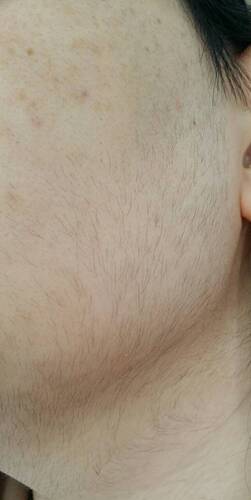I have hair like this all over the face, upper lip, chin, beard area and upper neck. I have started eletrolysis (thermolysis) but the electrologist wont give me an approx number of hours that i would need for complete clearance. can someone please let me know how many hours would it take?
Welcome! It’s very hard to predict a specific time because there are many variables. See below. The good news is that your hair is dark but fine, so it should respond well to treatment. If the hair on your chin and upper lip is thicker, I recommend getting those first, as they tend to hurt more and are more visible to others.
Your goal should be to get to where you have one full clearance, after which you will only be treating actively growing hairs. You might also talk with your electrologist about bleaching the hairs so you can see which ones are in anagen stage (actively growing). If you have not bleached before, use caution and do not to it shortly before or after electrolysis.
After the first full clearance, the time needed will drop a lot. Some people find that they are about halfway through after the first clearance in terms of total hours.
Factors affecting time to completion
The length of treatment needed to complete the process depends on many variables, presented roughly in order of importance:
Your choice of electrologists
As mentioned above, using someone who knows what they’re doing is paramount. The better the operator, the more hairs treated per session. Plus if they’re good, the kill ratio is higher, and you’re done faster.
Your density of follicles
The more follicles, the more hair, the more time it will take.
Your facial hair coarseness
Some people’s facial hair is coarser than others. Coarser hairs may take more than one insertion to come loose, and may be harder to kill.
Your pain threshold
The lower your pain threshold, the lower the machine must be set, and the longer it will take.
Your skin sensitivity
There is a limit to how much current your skin can take. For some people this is lower than their pain threshold. Trying to use a setting stronger than the skin can handle may result in skin damage.
Your frequency/regularity of treatment
It is vital that you maintain a regular treatment schedule set up by your electrologist. Do as much as you can afford. The sooner you get hairs after they emerge, the less time they have to strengthen. Some people miss appointments because they forget, they can’t afford to pay that week, or they don’t want to deal with the pain that day. Sporadic treatment will greatly lengthen the time needed to finish.
Your behavior at treatments
If you stop frequently to take a break from the pain, to go stretch your legs, to smoke, or to go to the bathroom, you will be cutting into your treatment time. Also, if you fidget a lot or talk a lot (especially while you’re getting work done near your mouth), your movements will slow down the whole process.
Your past methods of hair removal
If you have attempted to remove your facial hair prior to electrolysis, you may have made the task harder for your electrologist. Shaving shouldn’t pose a problem, but if you have plucked your hairs, the hair roots could be curved and distorted, making it difficult to insert the probe to the necessary point.
Your androgen levels
You don’t have to be on hormones for electrolysis to work, but it probably helps. While there is no definitive study on this, it is generally assumed that hormones (more specifically, anti-androgens like spironolactone) retard facial hair growth (although they have no effect on existing hairs). If you can, it is wise to get on a testosterone blocker like spironolactone before electrolysis.
Your age
The general assumption is that the closer to puberty you are, the less your beard will have come in. Of course, there’s a certain age where your facial hair is probably as thick as it will get, but this varies widely. And in general, the younger you are, the more resilient your skin is.
Your skin condition
If your skin is unhealthy or broken out, an electrologist may have to avoid an area until it’s healed.
Your modality of treatment
The different modalities of electrolysis (thermolysis, galvanic, and blend) all have their adherents and detractors. There has been no proof that one method works better than others in the long run, although you’ll certainly hear strong opinions for one method or the other.
Doubling up on treatment
Some places offer work done by two electrologists at once. Nicki writes, “I get twice the hours of work for the same number of hours of my lying there being tortured so it’s much quicker to make progress… It definitely is worth asking around to see if any electrologists in your area work in teams.”
So, as you can see, it depends.
Thanks Andrea, appreciate your detailed reply.
